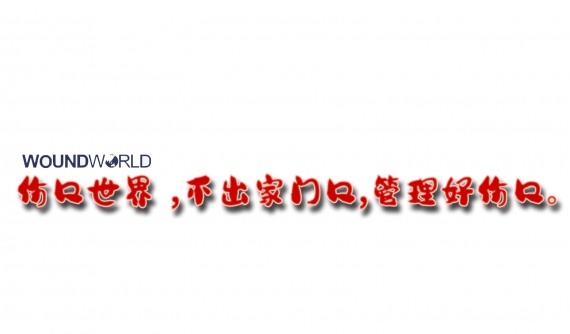Achronic wound is defined as a wound that failed to proceed through an orderly and timely process to produce anatomic and functional integrity (Werdin et al, 2009; Malaysian Ministry of Health, 2014). These wounds can last from four weeks up to more than three months, and are often associated with complications due to comorbidities including diabetes, vascular disease and trauma. In developed countries, it is estimated that 1 to 2% of the population will experience a chronic wound in their lifetime (Gottrup, 2004). These chronic wounds, which are difficult to heal, generally lead to a decrease in the patients quality of life, financial burden and increased morbidity rate (Järbrink et al, 2016; Yao et al, 2020). Based on a 2016 report from Wales, it is estimated that a 6% prevalence of chronic wounds attributes to 5.5% cost to the National Health Service (NHS) (Sen et al, 2019). Thus, modern wound care management is necessary to aid the healing of chronic wounds.
With great strides in technological innovation, a novel therapy was introduced. It provides a patented 4-in-1 solution for the treatment of a wide range of wound types (Nair, 2019). This wound care medical device has four main functions, disinfection, protection, wound hydration and restoration of the physiological condition of the area. The cream works by exerting the antimicrobial effects of silver (Ag+) concurrently with the disinfection properties of chlorhexidine and the moisture-balance properties of hyaluronic acid (Lu et al, 2017; Li et al, 2019). Simultaneously, silicon dioxide (Si02 ) forms a protective barrier over the wound (Sood et al, 2014).
Methodology
Patients from Wound Care Unit of Hospital Kuala Lumpur with chronic wounds cases including four venous leg ulcers (VLU), two diabetic foot ulcers (DFU) and one pressure ulcer/pressure injury (PU/PI) were enrolled in this study by convenient sampling. They were treated with a cream of Si02 silver ions, chlorhexidine and hyaluronic acid (KAdermin, Y.S.P. Industries (M Sdn. Bhd. ). The delivery and application of KAdermin cream to wounds has been simplified since all the individual components are packed collectively in a specialised tube. Patient’s details including age, past medical history, wound history and wound type were accumulated. Progress was recorded down by taking wound pictures and measuring wound sizes accordingly at baseline and the last observations.
In this case series, the wounds were cleaned and debrided where necessary. The cream was squeezed out onto a sterile surface and a layer of KAdermin cream was applied over the entire wound surface using a medical wooden spatula. The wounds were then covered with nonadhesive dressing. For highly exudative wounds polyurethane foam was used for absorption purpose. In all these cases, the wounds were bandaged and dressings were changed twice a week. All patients treated as per standard of care, DFU were offloaded, VLUs were treated with compression bandage and pressure relief was provided for the PU (Malaysian Ministry of Health, 2014; Nair, 2017; Mani et al, 2018).
To measure the pain in all these cases, a Visual Analog Score (VAS) with pain range from 0 to 10 where 0 indicated the absence of pain and 10 unbearable pain.
Results
Wound healing was observed and evidenced by the absence of infection, presence of granulation, reduction of pain as well as reduction of wound size (Frykberg and Banks, 2015). The patients’ data and wound evaluation are summarised as in Table 1 and Table 2. Cases 1–7 show the individual patients.
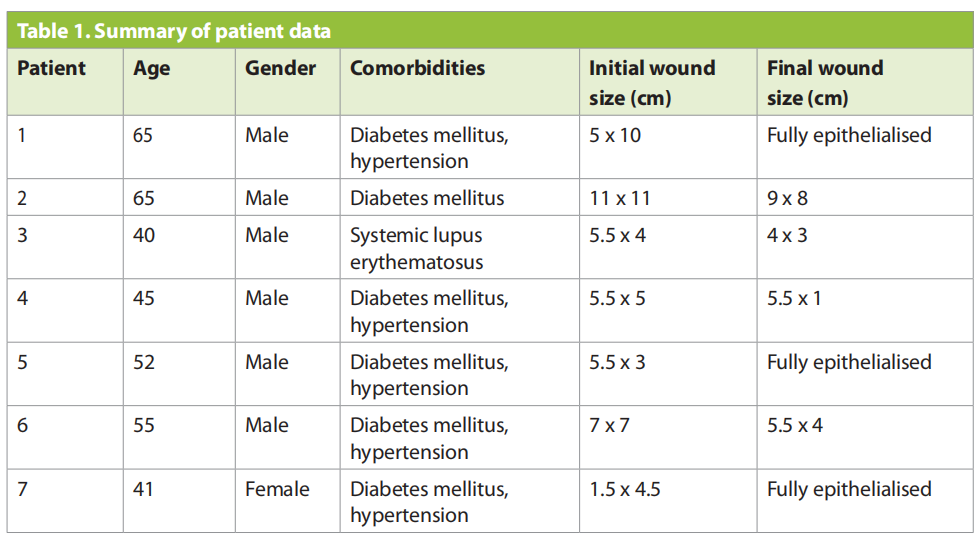
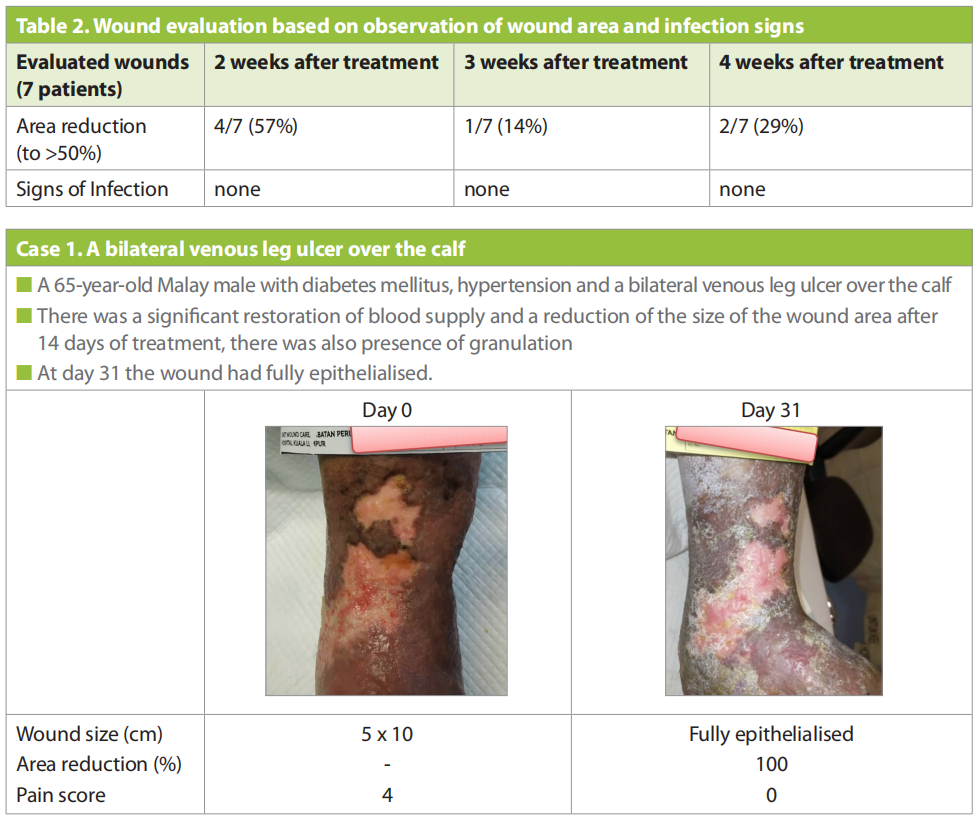
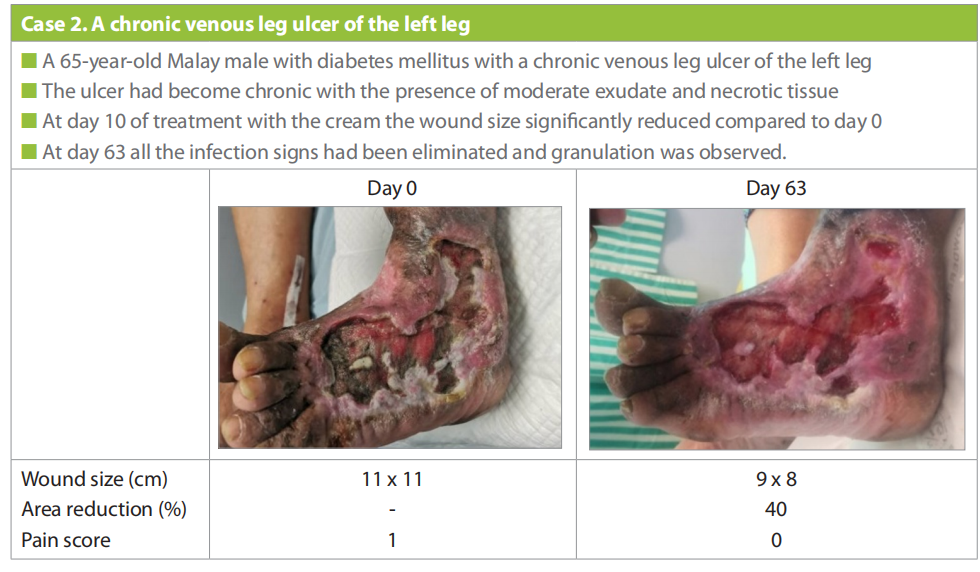
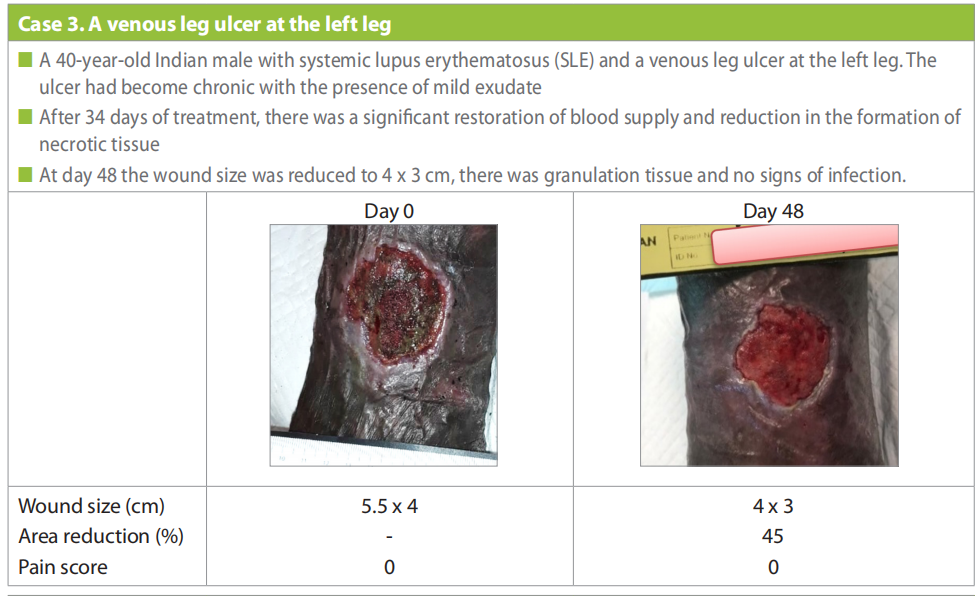
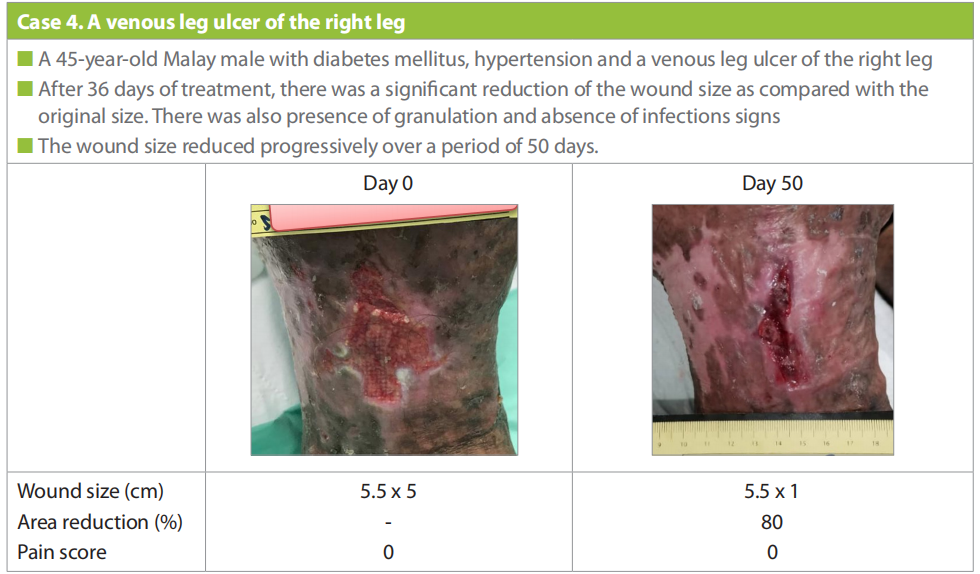
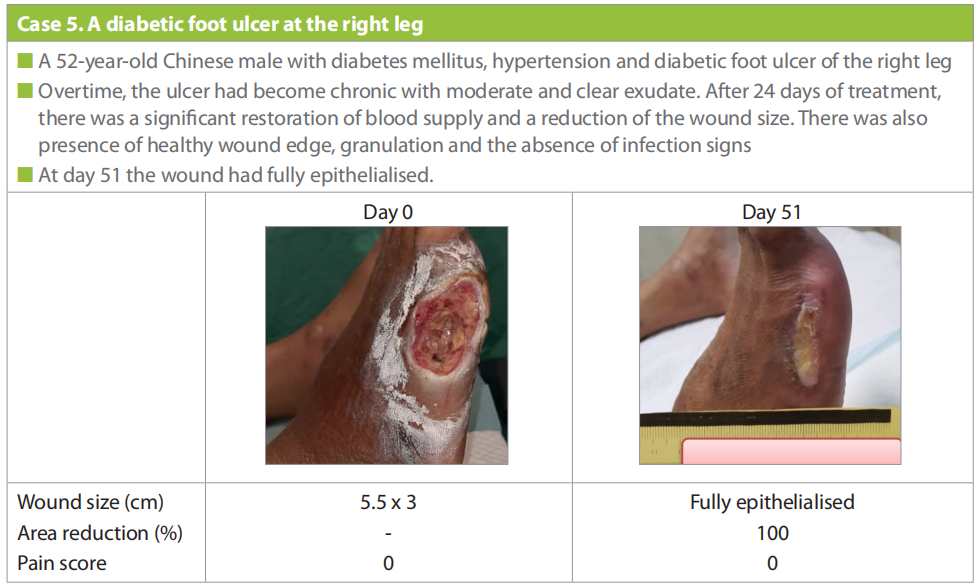
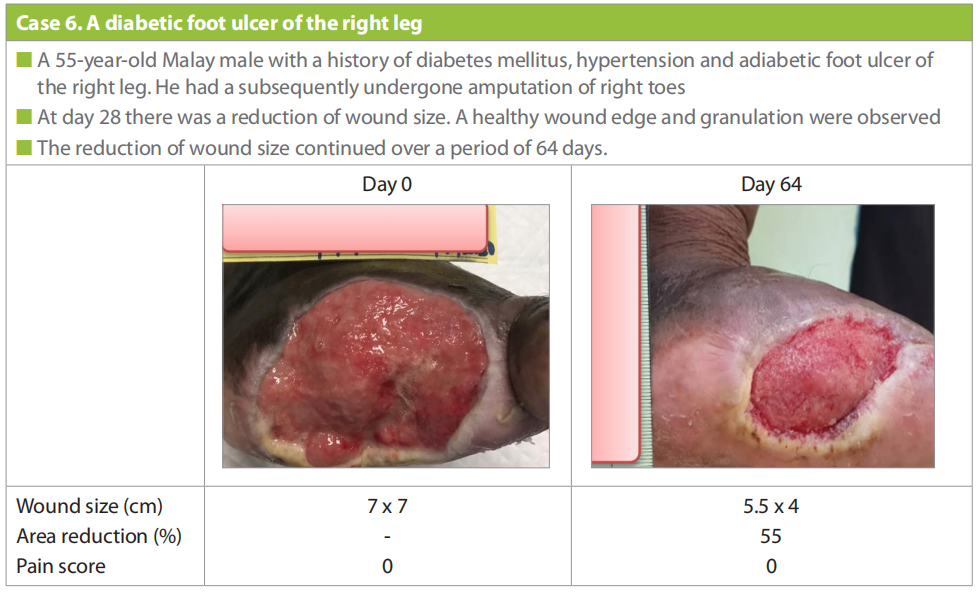
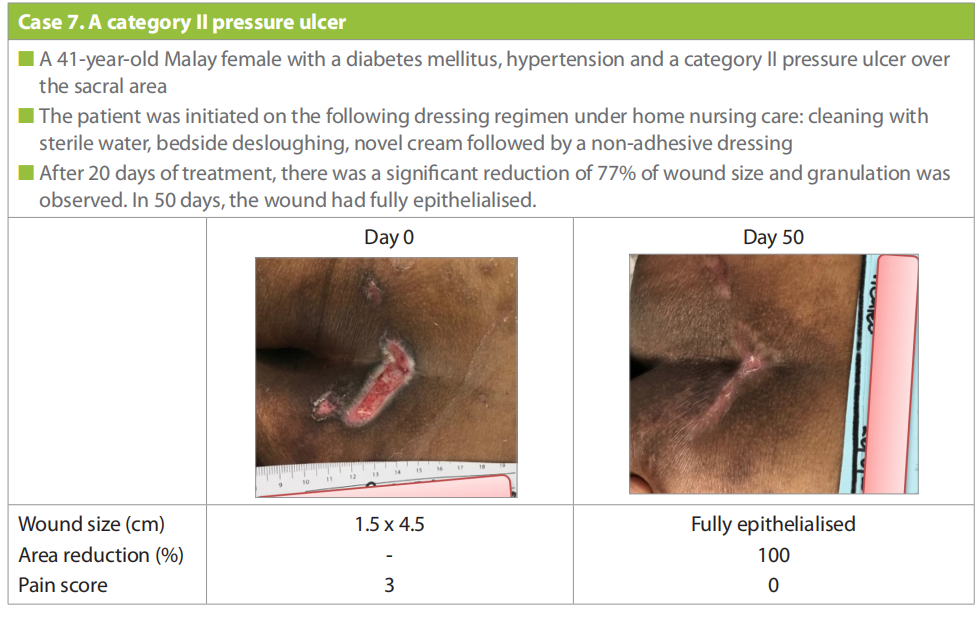
This case series consists of seven patients from Wound Care Unit of Hospital Kuala Lumpur was aimed to evaluate the efficacy of KAdermin cream. Among these seven patients, 57% of patients were older than 50 years old and 85% of all chronic wounds in this study occurred in the lower limb of patients, despite of the wound type variation.
After two weeks of treatment using the KAdermin cream, 57% of patients with chronic wounds were able to achieve an average wound reduction of more than 50%. 14% and 29% of patients with chronic wounds had the average wound reduction of more than 50% in 3 weeks and 4 weeks after treatment respectively.
Discussion
In all these patients, KAdermin cream creates a protective barrier with silicon dioxide to treat wounds, abrasions and minor burns, creating an environment protected from microbial aggression with silver as well as chlorhexidine and acting as a polymer film which favours the moisturising of tissues, thus accelerates granulation and physiological aspects of wound healing using hyaluronic acid (Lu et al, 2017; Li et al, 2019). The absence of infection signs was characterised by the absence of necrotic tissue, slough, pus and inflammation, while the moist wound healing method of KAdermin cream was demonstrated in the form of superficial epithelisation (Nair, 2019).
However, the sample size of this study was relatively small due to the limitation of subject availability. Thus, studies with larger sample size are needed to further support these observational findings.
Conclusion
The patented cream formulation of SiO2 - + Ag+ + chlorhexidine + hyaluronic acid was proven to be effective due to significant wound size reduction, absence of infection and presence of granulation as shown in current case series. The KAdermin cream exhibit broad spectrum antimicrobial properties of silver coupled with antiseptic properties of chlorhexidine, moisturising properties of hyaluronic acid as well as protective barrier of silicon dioxide (Nair, 2019).
Acknowledgement
KAdermin has medical device status and is distributed by Y.S.P. Industries (M) Sdn. Bhd.
References
1. Frykberg RG, Banks J (2015) Challenges in the treatment of chronic wounds. Adv Wound Care (New Rochelle) 4(9):560–82. https://dx.doi. org/10.1089%2Fwound.2015.0635
2. Gottrup (2004) A specialized wound-healing center concept: importance of a multidisciplinary department structure and surgical treatment facilities in the treatment of chronic wounds. Am J Surg 187(5A):38S–43S. https://doi.org/10.1016/s0002- 9610(03)00303-9
3. Järbrink K, Ni G, Sönnergren H, Schmidtchen A et al (2016) Prevalence and incidence of chronic wounds and related complications: a protocol for a systematic review. Syst Rev 2016 5(152). https://doi.org/10.1186/ s13643-016-0329-y
4. Li X, Li A, Feng F (2019) Effect of the hyaluronic acidpoloxamer hydrogel on skin-wound healing: in vitro and in vivo studies. Animal Model Exp Med 2(2): 107–13. https://dx.doi.org/10.1002%2Fame2.12067
5. Lu MM, Wang QJ, Chang ZM (2017) Synergistic bactericidal activity of chlorhexidine-loaded, silverdecorated mesoporous silica nanoparticles. Int J Nanomedicine 12: 3577–589. https://dx.doi. org/10.2147%2FIJN.S133846
6. Malaysian Ministry of Health (2014) Wound Care Manual. First Edition. https://tinyurl.com/tnh7pw64
7. Mani R, Rerkasem K, Nair HKR, Shukla V, eds (2018) Compression and Chronic Wound Management. Springer, Basel, Switzerland
8. Nair HKR (2017) The Compendium of Wound Care Dressings & Other Modalities In Malaysia (4th edn)
9. Nair HKR, Ilwani NZ (2019) A patented formulation of SiO2- + Ag+ + Chlorhexidine + Hyaluronic acid. Wounds Asia 2(3):34–9.
10. Sen CK (2019) Human wounds and its burden: an updated compendium of estimates. Adv Wound Care (New Rochelle) 8(2):39–48. https://doi.org/10.1089/ wound.2019.0946
11. Sood A, Granick MS, Tomaselli NL (2014) Wound Dressings and Comparative Effectiveness Data. Adv Wound Care (New Rochelle) 3(8): 511–29. https:// dx.doi.org/10.1089%2Fwound.2012.0401
12. Werdin F, Tennenhaus M, Schaller H, Rennekampff, H (2009) Evidence-based management strategies for treatment of chronic wounds. Eplasty 9:e19
13. Yao Z, Niu J, Cheng B (2020) Prevalence of chronic skin wounds and their risk factors in an inpatient hospital setting in northern China. Adv Skin Wound Care 33(9):1–10 https://doi.org/10.1097/01. asw.0000694164.34068.82
This article is excerpted from the Wounds Asia 2021 by Wound World.
